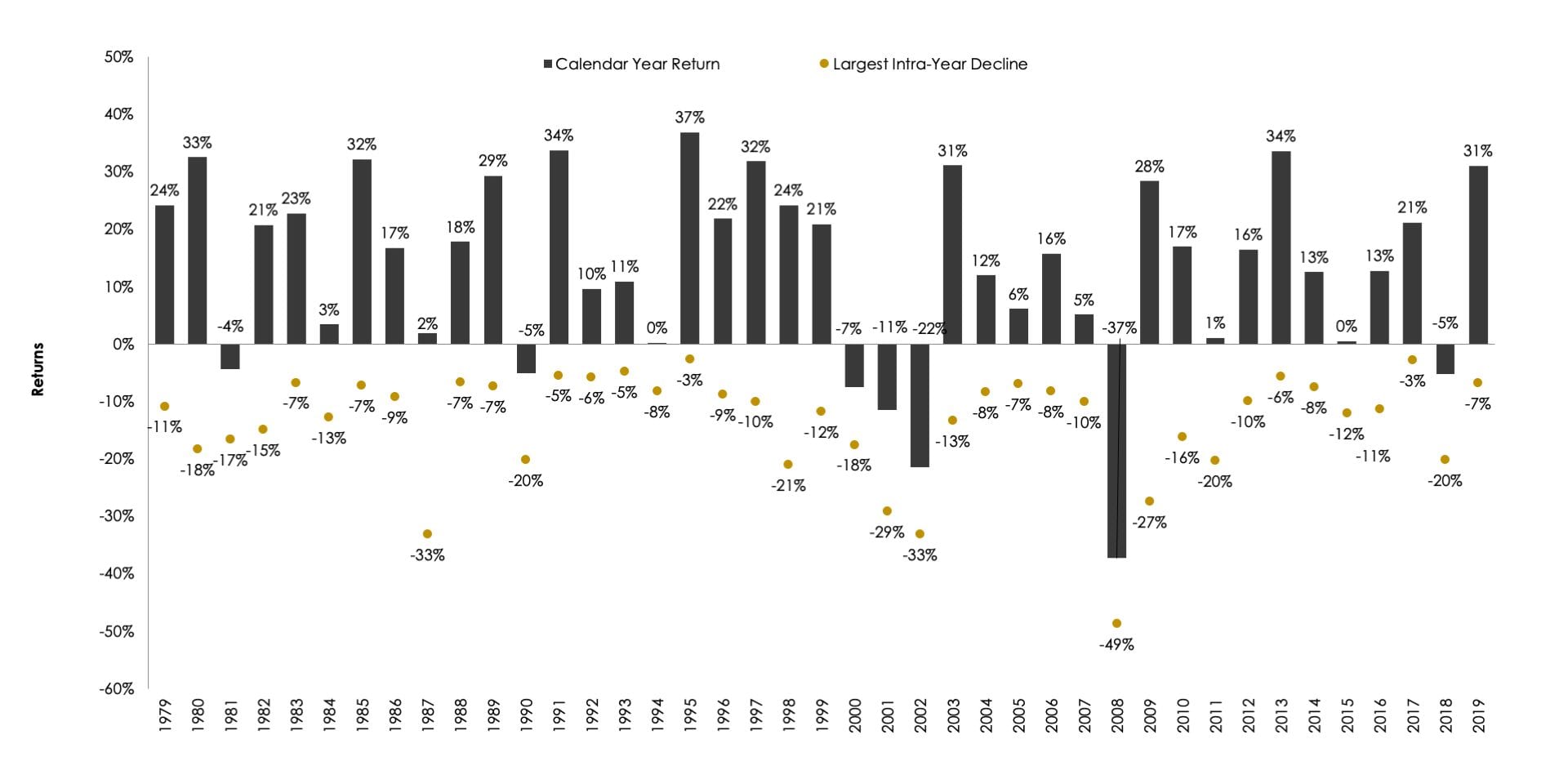The Market Is Down. What Should You Do?
While we are often asked, “How is Brighton Jones responding to recent market volatility?”, it is perhaps more informative to review what we have done leading up to this point.
Over the past week, global equity markets have sold off in dramatic fashion. The U.S. stock market, as measured by the Vanguard Total Stock Market Index ETF, is approximately 12 percent below its all-time high set on February 19. Much of the downward price movement occurred swiftly, with equity markets suffering three percent losses on consecutive days.
While market declines of this magnitude can be unsettling for investors, they are a regular occurrence by historical measures. Consider the 41 years of history illustrated in the chart below, with maximum intra-year price declines (yellow dots) plotted against calendar year price returns (gray bars) for the Russell 3000 Index.
2020 Market Volatility
- 10 Lessons From the Financial Crisis That Stand the Test of Time
- Timeless Investment Truths in Uncertain Times
- Revisiting Your Portfolio Strategy As Bear Market Looms
Since 1979, the average of intra-year declines has been 14 percent during a period in which the index generated an annualized return of nearly 12 percent. Most recently, equity markets suffered a 20 percent decline in the fourth quarter of 2018, before rallying 31 percent to new all-time highs in 2019.
Calendar Year Returns vs. Intra-Year Declines (Russell 3000 Index, 1979 – 2019)
Our Response to Recent Market Volatility
Whenever equity markets are in the midst of a pullback, individual investors are often advised to “stay the course.” This is good advice. Investors should not change a strategy they put in place during rational times when an unfavorable outcome they knew was inevitable (i.e., a market decline) eventually comes to pass. Indeed, we similarly advise our clients to “stay the course” when equity market performance turns negative.
While advising clients to stay the course has the potential to come across as dismissive of prevailing or potential risks, we remain confident in giving this advice because of the steps we have already taken to prepare our clients and their portfolios. While we are often asked, “How is Brighton Jones responding to recent market volatility?”, it is perhaps more informative to review what we have done leading up to this point:
Recent Investment Model Changes
- July 2017: We introduced revisions to our investment model that reduced our equity exposure by five percent. In a letter to clients, we cited elevated equity valuations as the primary reason for the adjustment.
- August 2018: We introduced revisions to our investment model that shifted the make-up of our fixed-income holdings. We increased our exposure to non-core fixed-income market segments (i.e., private credit, inflation-protected bonds, high yield bonds, floating-rate bonds) that would be beneficial to own in an environment with positive economic growth but unstable interest rate policy and inflationary pressures.
- Having implemented these adjustments, our most aggressive portfolios have a 30 percent allocation to fixed-income securities. By comparison, an aggressively allocated target date retirement fund will have only a 10 percent allocation to fixed-income securities.
Ongoing Rebalancing
- Rebalancing is the process of realigning the weightings of portfolio holdings as performance across market segments diverge over time. In the context of a broadly diversified investment portfolio, rebalancing typically involves taking profit from positions with the strongest performance and replenishing exposure to positions that performed more modestly.
- While it might not seem intuitive or logical to take profit from the best performers, especially if they continue to perform well, it can prove beneficial both emotionally and financially to have done so over a full market cycle. As the saying goes, it is better to rebalance your portfolio before the market rebalances it for you!
- As global stock markets have produced double-digit percentage gains over the past ten years, we have methodically redistributed profit from our equity positions to less volatile market segments (as the weightings of our holdings drifted from their targets). As noted, rebalancing can detract from returns when high performing market segments continue to produce strong returns, but rebalancing eventually proves its merits when the tide turns.
Aligning Client Allocations With Cash Needs
- It goes without saying that investors generally prefer high returns to low returns. But, the key to assuming risk responsibly in pursuit of higher returns is to give each asset class an adequate amount of time to achieve its long-term expected rate of return. That is why we set allocations based on the timing and amounts of each client’s anticipated cash needs.
- We protect the first eight years of anticipated cash needs in a Capital Preservation Portfolio, and the next six years in a High Income Portfolio—which buys us a 15+ year time horizon on monies allocated to Global Equity.
- In cases where our clients do not have any anticipated cash needs for the foreseeable future, our model calls for a minimum allocation of 10 percent to Capital Preservation and 20 percent to High Income—as noted earlier, this means our most aggressive portfolio currently has 30 percent allocated to fixed-income securities.
Conclusion
During periods of heightened equity market volatility, financial experts often quip, “Don’t just do something, stand there!” To some, this advice may come across as dismissive of prevailing or potential risks. But, in our case, we are confident advising our clients to stay the course because (1) we have already made the necessary adjustments to our investment model over the past two years, and (2) we have a proven process for effectively managing client portfolios through periods of heightened volatility.
We will continue to monitor this situation and provide updates as it unfolds. In the meantime, please do not hesitate to contact your planning team with any questions.
Read more from our blog:






